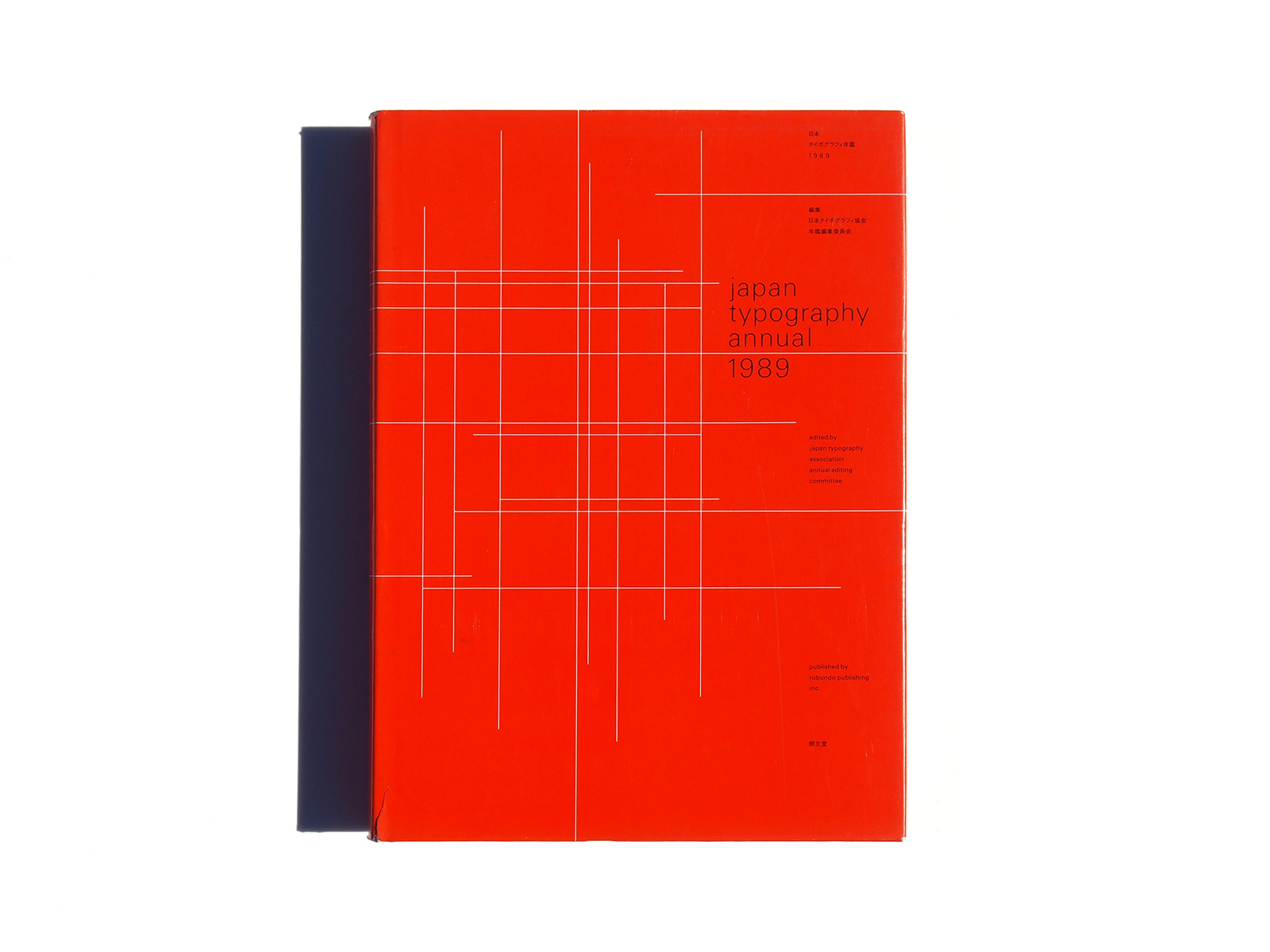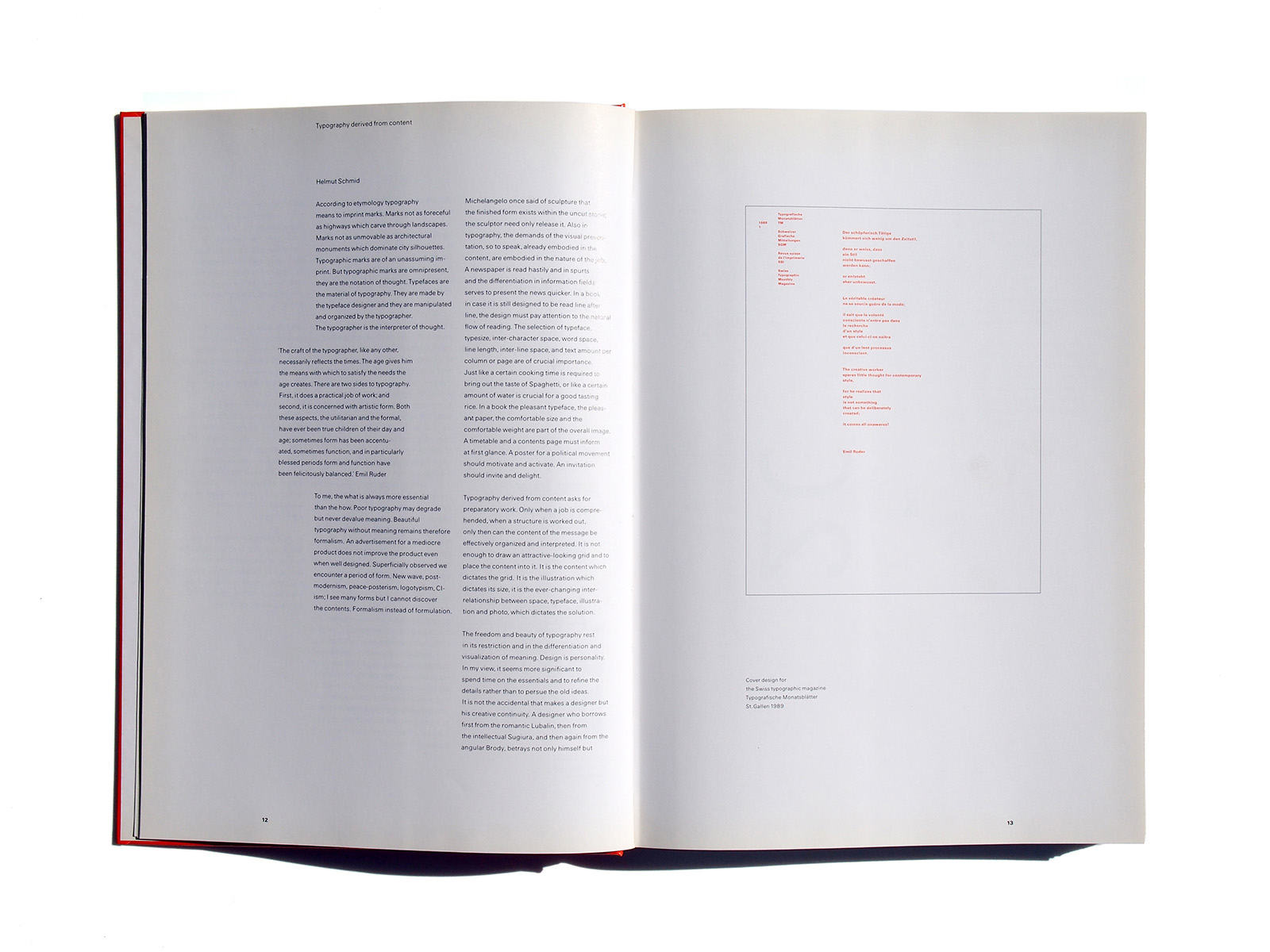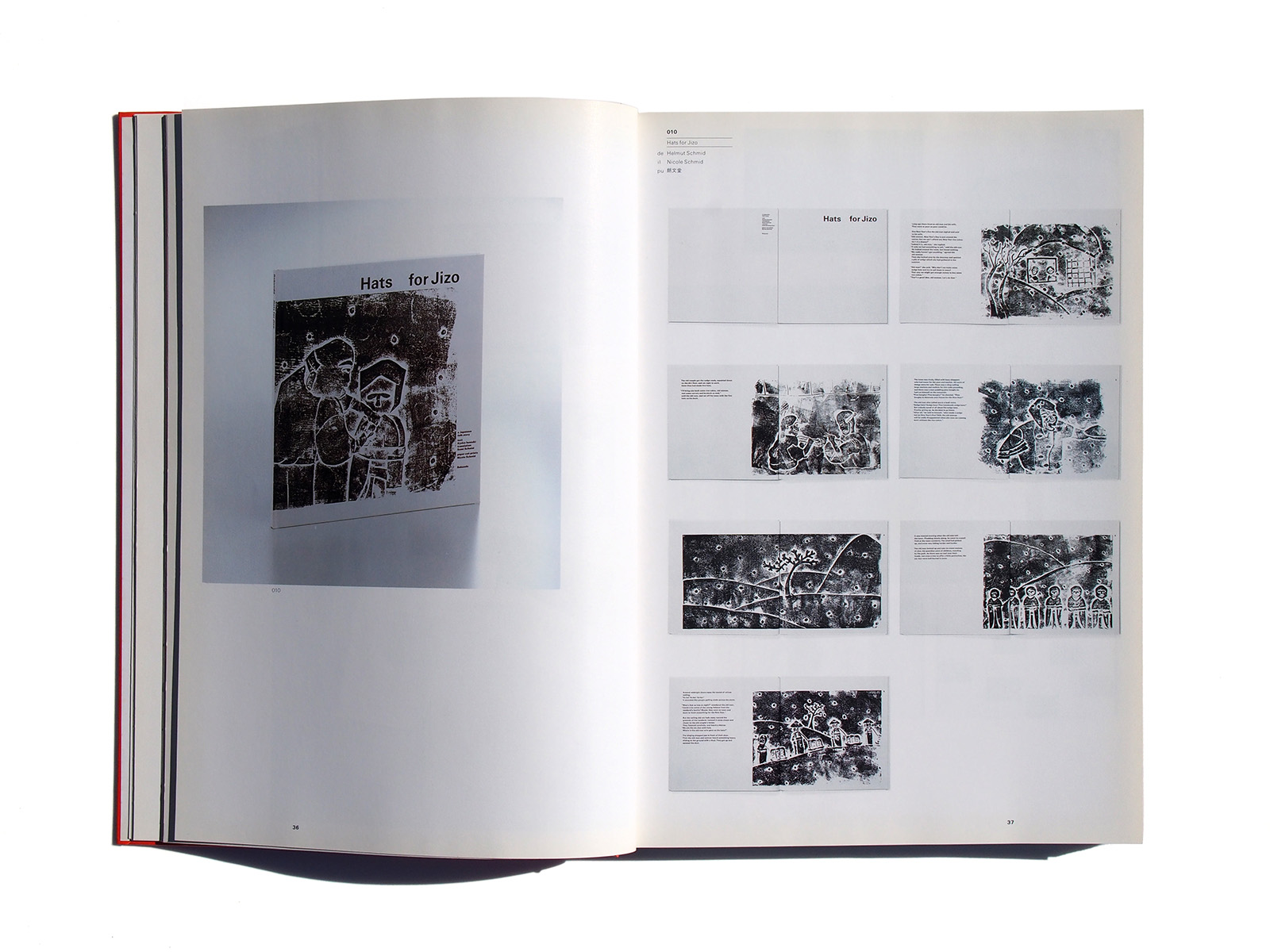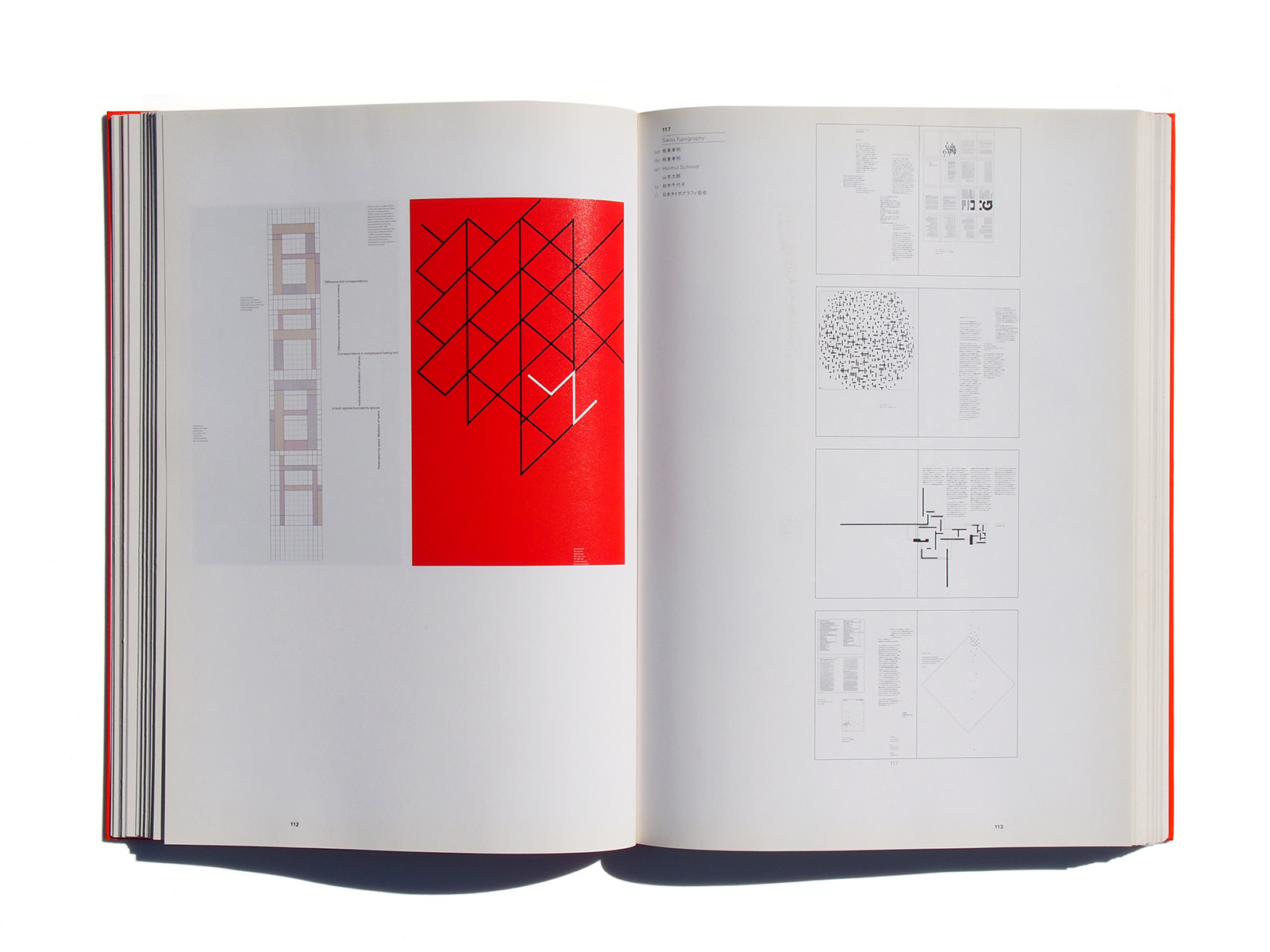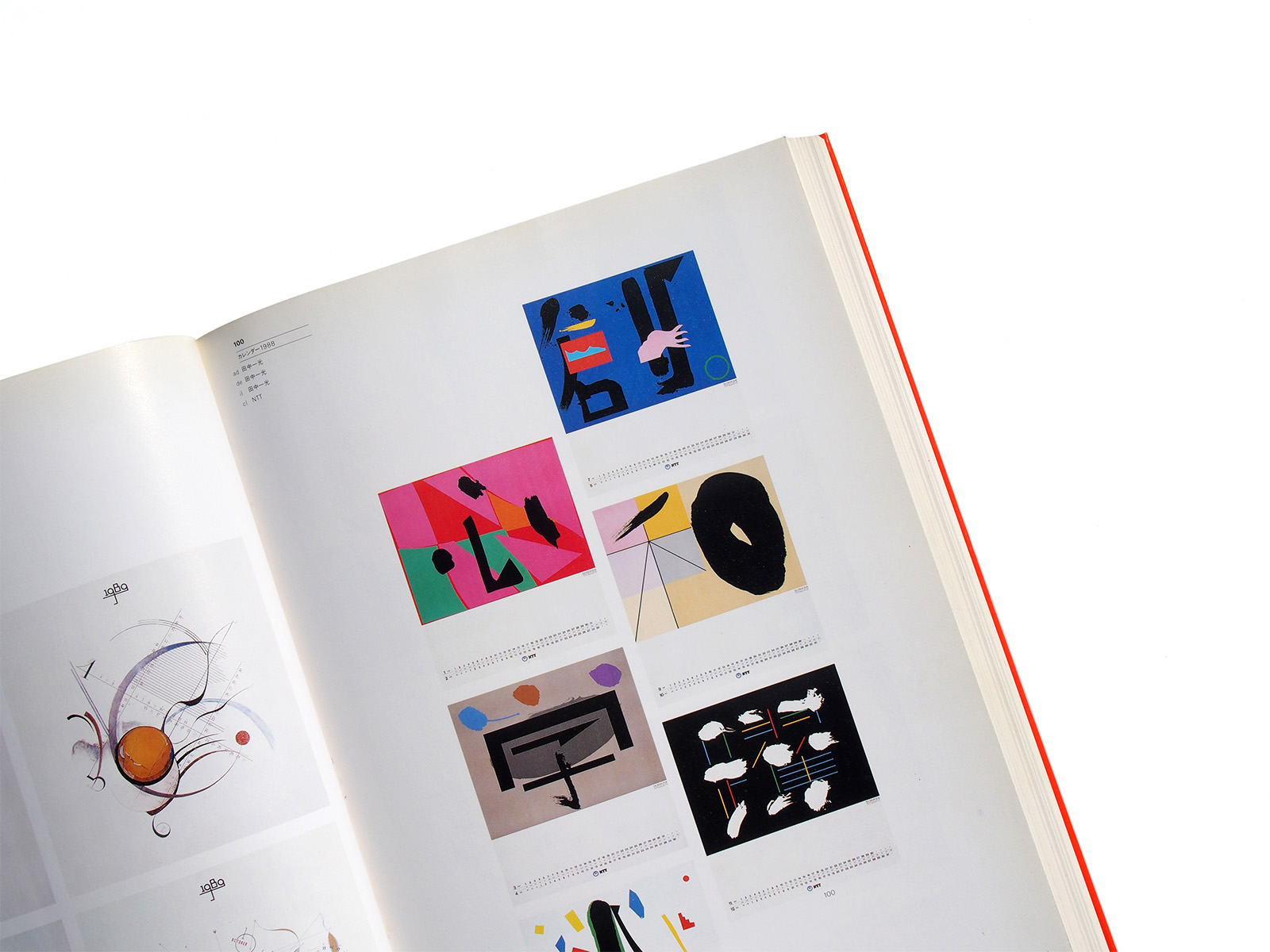Publisher: Robundo
Language: Japanese English
ISBN-10: 494761322X
ISBN-13: 978-4947613226
Product Dimensions: 29.6 x 21.4 x 3.4 cm
Release Date: 1989
Price: sold
Book Design: Takaaki Bando
Typography derived from content
Helmut Schmid
According to etymology typography
means to imprint marks. Marks not as forceful as highways which carve through landscapes Marks not as unmovable as architectural monuments which dominate city silhouettes. Typographic marks are of an unassuming imprint. But typographic marks are omnipresent, they are the notation of thought. Typefaces are the material of typography. They are made by the typeface designer and they are manipulated and organized by the typographer.
The typographer is the interpreter of thought.
‘The craft of the typographer, like any other.
necessarily reflects the timesThe age gives him the means with which to satisfy the needs the age creates. There are two sides to typography. First, it does a practical job of work; and second, it is concerned with artistic form. Both these aspects, the utilitarian and the formal, have ever been true children of their day and age; sometimes form has been accentuated, sometimes function, and in particularly blessed periods form and function have
been felicitously balanced.‘ Emil Ruder
To me, the what is always more essential
than the how. Poor typography may degrade but never devalue meaning. Beautiful typography Without meaning remains therefore formalism. An advertisement for a mediocre product does not improve the product even when well designed. superficially observed we encounter a period of form. New wave, post-modernism, peace-posterism, logo typism, Cl ism; I see many forms but I cannot discover
the contents. Formalism instead of formulation.
Michelangelo once said of sculpture that
the finished form exists within the uncut stone; the sculptor need only release it. Also in typography, the demands of the visual presentation, so to speak,already embodied in the content, are embodied in the nature of the job. A newspaper is read hastily and in spurts
and the differentiation in information fields serves to present the news quicker. In a book,
in case it is still designed to be read line after line, the design must pay attention to the natural of reading‘ The selection of typeface, typesize, inter-character space, Word space,
line length, inter-line space, and text amount per column or page are of crucial importance.
Just like a certain cooking time is required to bring out the taste of Spaghetti, or like a certain amount of Water is crucial for a good tasting rice. In a book the pleasant typeface, the pleasant paper, the comfortable size and the comfortable weight are part of the overall image. A timetable and a contents page must inform
at first glance. A poster for a political movement should motivate and activate. An invitation
should invite and delight.
Typography derived from content asks for preparatory work. Only when a job is comprehended, when a structure is worked out,
only then can the content of the message be effectively organized and interpreted. It is not enough to draw an attractive-looking grid and to place the content into it. It is the content which dictates the grid. It is the illustration which dictates its size, it is the ever-changing interrelationship between space, typeface, illustration and photo, which dictates the solution.
The freedom and beauty of typography rest in its restriction and in the differentiation and visualization of meaning. Design is personality. In my view, it seems more significant to
spend time on the essentials and to refine the
details rather than to persue the old ideas.
It is not the accidental that makes a designer but
his creative continuity. A designer who borrows first from the romantic Lubalin, then from the intellectual Sugiura, and then again from the angular Brody, betrays not only himself but also the professional ethic Then design becomes just a supermarket and the designer functions only as the salesman of styles of fashion. It was Matisse who said that the personality of an artist is shaped in the fights which
he has to carry out. Typography must be challenging and inventive, but it must also be honest and credible. To work in typography means
to have fights. Fights for a personal expression. Fighting off fashionable trends. Ignoring useless and tasteless typefaces. l believe that the typographer who can see and apply the elegance of Garamond, the economy of Times and the gracefulness of Univers has gained
freedom in his Work.
I understand typography not as a masquerade of typeforms but as a stage setting of con~ tents. Decorations on typeforms are similar to todays TV talents who hide their thin voices behind fancy dress costumes and robot-like gestures But neither do 1 mean boring and evenly grey character—landscapes as they appear in misunderstood modern typography. Just as in music, Where 12 tones and the interval are enough to notate any possible melody, so too can a typographic work be expressed
with one typeface family and the use of space.
On the technical side the possibilities have,
in the meantime, increased incredibly. Even the smallest involvement with type today creates new problems for us. The margins for individual decision making have increased, but sotoo have the margins for errors. Nowadays,
detail needs to be redefined for practically each new job, leading to a time-consuming and
costly working condition.
Good typefaces are sensitive. They have characteristics, they have needs, they have iife. Univers depends on open inter~character spacing, on good detail work, and on a generous layout. Helvetica and Times are rather modest in their working conditions. And Rotis needs yet to be assessed. Without familiarisation with a typeface printed matter will always be
legible, but will lack expression. Why do new typefaces have so little success? Not only because they are inferior, but also because they have no interpreters. In principle, anyone can make a noise on an instrument, but it takes
practice to play it. The same must surely apply to typography.
Visually, characters are sound sculptures.
The minutest change made to a part of a design requires a revamping of the whole. This point becomes significant in the design of a logotype, because in a logotype a limited number of characters must be united into a new harmony. The smallest detail in the thickness of strokes, inform and counter form, in rhythm and space,
separate a good logotype from a poor logotype.
A logotype should be an unobtrusive
part of the product itself, but it should have a certain identification value, a mnemonic device, to stand on its own in an advertisement or in
a TV commercial. But the logotype should never become just an image maker but a signature
of quality for a product or company.
The typographer, the designer, is not only confronted to give shape to content, but he has a responsibility to save the valuable and not just to replace the old and proven with the modern and modernistic. Some of the typographic
rules make sense even today and should not be ignored or forgotten. Not every company symbol needs to be renewed, nor every logotype transplanted and “improved” into the Roman
alphabet and not every space needs to be
“designed”and destroyed.
One criteria of a typeface is its usability.
One criteria of a typographic Work is its success. And success in typography does not necessarily mean when it is selected in an annual or for an exhibition, but when the content reaches
the anticipated reader in the same Way as it was intended by the author and interpreted by the typographer.
ヘルムート・シュミット
タイポグラフィは語源学によれば、跡を刻むという意味である。それは、景観を割って走るハイウェイのように力強い軌跡でもなければ、都市の輪郭(シルエット)を支配する大きな記念碑のように不動の形でもない。
タイポグラフィっくな記号は、もっと謙虚であるが、同時に随所に存在する。それは思考を記号により表現するものである。タイプフェースデザイナーによって作られ、タイポグラファによって使われ、意味をなす。
タイポグラファの思考は通訳者である。
タイポグラファの仕事は、他のあらゆる仕事と同様、必然的に時代の影響を受ける。彼は時代の生み出すニーズを満足させる手段を、時代によって、与えられる。タイポグラフィには、二つの相対する面がある。ひとつは実際の仕事という面であり、他は芸術的な造形という面である。これらの二つの面、すなわち実理性と芸術性は、常に時代の申し子であった。
フォルムがより強調された時代もあり、機能が優先された時代もあった。そしてフォルムと機能が申し分なく調和した幸運な時代もあった。
エミル・ルーダー
わたしにとっては、What[何が]がHow[いかにして]よりも、常に重要である。拙いタイポグラフィは、品位を落とすことはあっても、内容の価値を引き下げることは決してない。美しいが意味をなさないタイポグラフィは、従って、形式主義から脱することはない。
凡庸な製品の広告は、たとえ美しくデザインされていても、製品の質を高めることはない。ごく表面的な観察であるが、わたしたちは、今、フォルムの時代の直中にいる。ニュー・ウェーブ、ポスト・モダニズム、ピース・ポスターリズム、ロゴタイピズム、CI-イズム; 実に多くのフォルムがあるが内容があるものが見当たらない。公式化[フォーミュレーション]ではなくて形式主義[フォーマリズム]。
「完成作品のフォルムは、すでに素材の石の中に存在している。彫刻家のなすべきことはそれを解放してやるだけだ」これは、ミケランジェロが、彫刻についていった言葉であるが、タイポグラフィについても同様、ヴィジュアルプレゼンテーションへの要求は、すでに内容に包含されている。すなわち、仕事の本質の中に体現されているのである。新聞は急いで読まれたり、あちこち飛んで読まれたりする。だから、必要な情報だけを、より早くキャッチできるように、ひとつの紙面に様々な差異をもたせて割りつけてある。本については、但し、本が依然として1行1行読まれるものとしてデザインする場合の話だが、読むという行動の自然な流れを念頭においてデザインすべきである。
書体の選定、タイプサイズ、字間スペース、語間スペース、行の長さ、行間スペース、1コラム、1ページあたりの本文の量は、決定的な重要性をもっている。それはちょうど、スパゲティのうまさを引き出すためには適格なゆで時間が、おいしいごはんには正確な水加減が決定的であるのと同じである。感じのよいタイプフェイス、感じのよい紙、心地よいサイズ、心地よい重さも、本全体のイメージにかわる。
時刻表や目次は、一目でわかるものでなければならない。招待状は、誘いかけ、喜びを与えるものでなければならない。
内容から出発するタイポグラフィは、準備の作業が必要である。仕事を十分に理解し、構成を練ってこそ、はじめての内容が有効に視覚化され、通訳されるのである。見事なグリッドを引いて、それを内容にはめ込んだだけでは十分ではない。内容がグリッドを支配するのである。図版自体が図版のサイズを
決定するのである。解決のカギはスペース、タイプフェイス、図版そして写真の間の、決して一定でない相互関係にあるのだ。
タイポグラフィの自由と美は、その制約に、その内容の区別化と視覚化に依存している。デザインはパーソナリティである。古いアイデアを追い求めるよりも、本質的な要素に時間をかけ、ディテールを洗練することのほうがはるかに重要だと、私は考える。
偶然ぱっと輝いた作品だけではデザイナーとは言えない。継続的に創作できてこそ、デザイナーである。まずはロマンチックなルバーリンに始まり、次に知的な杉浦に移り、そして目下角ばったブロディから、といったぐあいに専ら借物に頼っているデザイナーは己自身のみならずプロとして’の倫理にも背いているのである。これでは、デザインは、まるでスーパーマーケットであり、デザイナーは当世はやりのスタイルを商うセールルマンの役目を果たしているにすぎない。マチスは「芸術家のパーソナリティは、己に課せれた戦いの中で形成される」と述べている。タイポグラフィは戦いを恐れず、独創的でなければならないが、しかも、誠実で信頼できるのでなければならない。
タイポグラフィに携わることは戦いを意味する;
自分自身の表現のために闘い、流行のトレンドを撃退する闘い、役にも立たない品のないタイプフェイスを無視する闘い。
ガラモンのエレガンス、タイムスの経済性、ユニバースの気品を理解し、使いこなせるタイポグラファは、自己の仕事をについて自由を獲得したと言えよう。タイポグラフィとはタイプフェイスの仮面舞踏会ではなく、内容のためのステージセッティングだとわたしは理解している。タイプフェイスに施した装飾は、声の貧弱さをファンシードレスとロボットのようなジェスチャーでごまかしている今日びのアイドル歌手に似ていると思う。だからといってわたしは、モダン・タイポグラフィが、しばしば誤解されているように、退屈で、単調な、灰色の文字の風景がと言っているのではない。音楽において、十二音と休止符があらゆるメロディを表記するに十分であるように、タイポグラフィにおいては、ひとつのタイプフェイス・ファミリーとスペースの使用が、ひとつの作品を表現するのに十分である。
一方、技術的側面に目を転じると、昨今の発展はめざましく、可能性は信じがたいほど拡大した。タイプに関わる、ごくささいな点でも、わたしたちに新しい問題を投げかけてくる。デザイナー個人が決定できる範囲は確かに拡大したが、同時に誤りをおかしうる範囲も拡大した。今日、あらゆる新しい仕事に関して、ディテールを今一度明確にし直す必要が生じてきた。その結果、制作にかかる時間もコストも大きく増加した。
秀れたタイプフェイスは、敏感である。特色を具え、要求をもち、生命をもっている。ユニバースは広い時間スペースを要求し、ディテールへの十分な配慮と気前のよいレイアウトを必要とする。ヘルベチカとタイムスの要求はやや穏当である。ローティスはまだまだ評価の余地がある。タイプフェイスに精通しなくても、印刷物は必ず読める。ただ、それは表現力の貧しいものになろう。新しいタイプフェイスがなかなか成功しないのはなぜだろうか。それは、タイプフェイスが劣っているからだけではない。通訳者をもたないからである。誰でも楽器で、一応音を出すことはできる。しかし、奏でようと思えば、訓練が必要である。この原則は、タイポグラフィにおいても、当然適用されるべきである。
視覚的に、文字はサウンド・スカルプチャである。
デザインの一部になされたごくわずかな変更のために、全体の改造が必要となる。この点はロゴタイプのデザインにおいてとりわけ重要である。
なぜなら、限られた少ない字数を統合して、ひとつの新しいハーモニーを創らなければならないからである。秀でたロゴタイプと劣ったロゴタイプの差は、文字の太さ、フォームおよびカウンターフォーム、リズム、スペース等における、ごく微妙なディテールで決まるのである。
ロゴタイプは製品そのものを妨害しないものでなければならない。しかし広告やTVコマーシャルで自立すべく、アイデンティフィケーションや記憶に残るポイントは必要である。ロゴタイプは製品や会社に加えた単なるメーキャップになってはならない。製品や会社の質を表すサインになるべきである。
タイポグラファやデザイナーが直面する問題は、内容に形を与えることだけではない。古いもの、保証付のものを、現代的あるいは当背風なもので置きかえることだけではない。真に価値のあるものを守ることに責任を持たなくてはならない。
タイポグラフィのルールの中には、今なお意味をなし、無視したり忘れたりできないものもある。すべての会社のマークを更新する必要はなく、あらゆるロゴタイプをアルファベットに移植し、”改善化”する必要もない。あらゆるスペースを”デザイン化”そ、破壊する必要もない。
タイプフェイスの評価基準[クライテリア]のひとつは、使えるということである。タイポグラフィ作品の評価基準のひとつは、成功である。タイポグラフィにおける成功とは、必ずしも年間に掲載されたり、展覧会に入選することではない。タイポグラフィの成功は内容が、作者が意図し、タイポグラファが通訳したように、読んでほしい読み手に届くことである。
本文より
